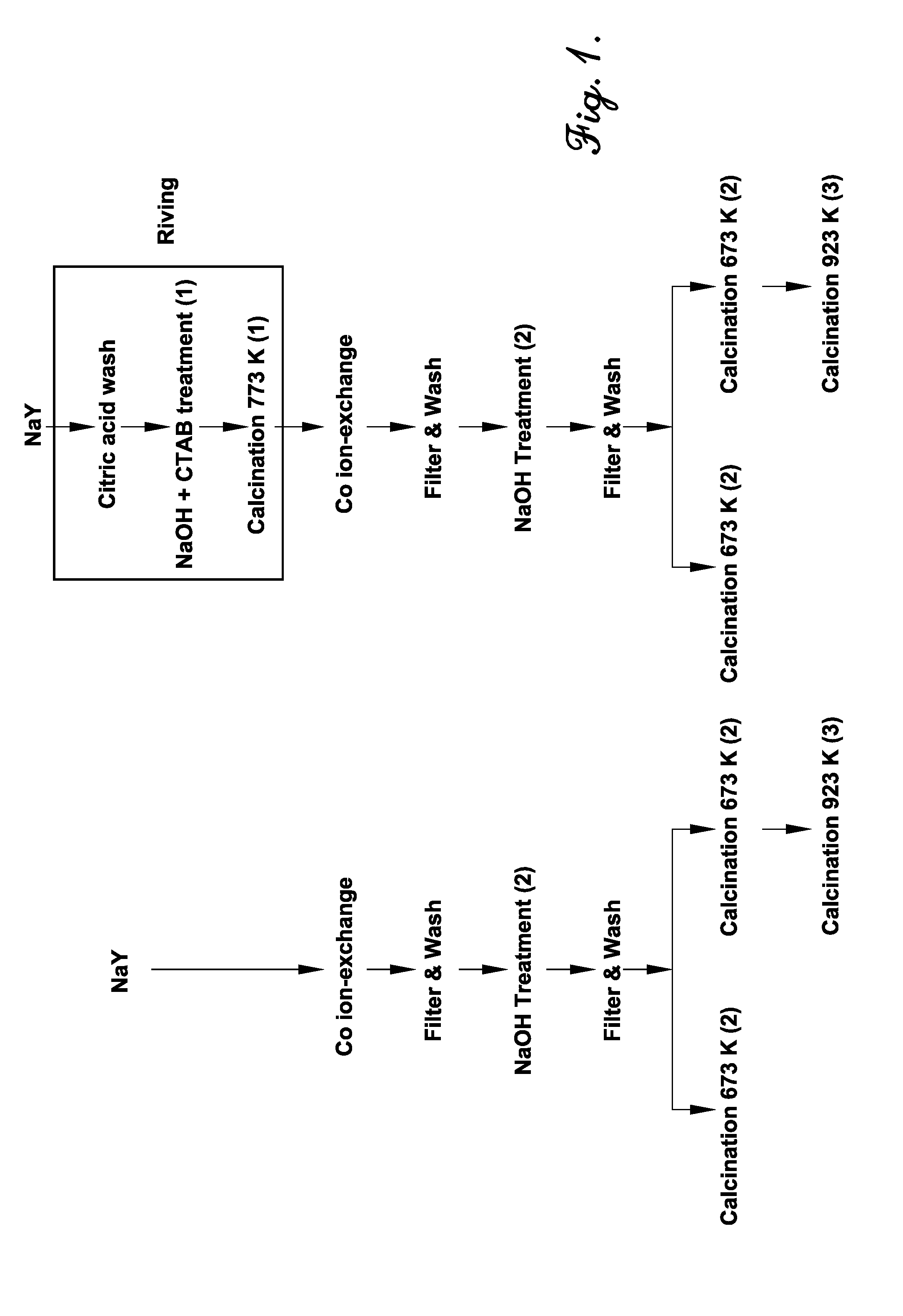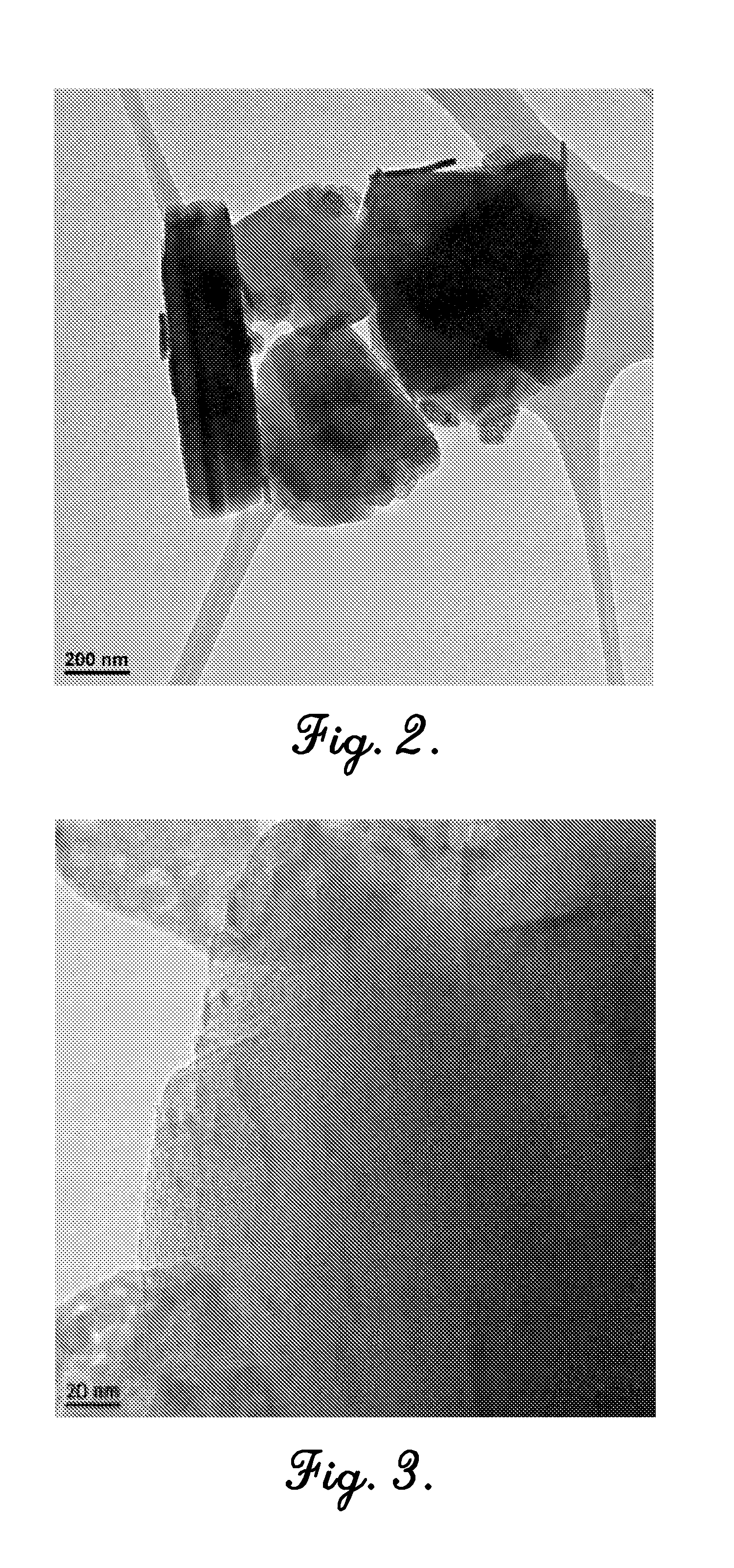Mesoporous zeolite catalyst supports
- Summary
- Abstract
- Description
- Claims
- Application Information
AI Technical Summary
Benefits of technology
Problems solved by technology
Method used
Image
Examples
example 1
[0086]In this example, cobalt oxide nanoparticles were synthesized inside the cages of a zeolite by a method including three steps: (i) ion-exchange of cobalt ions into the zeolite, (ii) precipitation of cobalt ions with sodium hydroxide within the supercages of the zeolite, and (iii) calcination. Two types of zeolite, a commercial NaY zeolite and a mesoporous NaY zeolite, were analyzed in this example. In addition, two calcination temperatures (673 K and 923 K) were tested to study the effect of mesoporosity on the migration and agglomeration of the catalyst nanoparticles, which negatively affects catalytic performance.
[0087]The zeolites used in this study were a commercial NaY zeolite and a modified version thereof that had been subjected to a mesopore formation process (“riving”) involving subjecting the zeolite to an acid wash with citric acid and then treatment with NaOH and CTAB at 80° C.
[0088]Zeolite-encapsulated cobalt oxide nanoparticles were then synthesized by the followi...
example 2
[0092]In this example, cerium oxide nanoparticles were synthesized inside the cages of a zeolite by a method including three steps: (i) ion-exchange of cerium ions into the zeolite, (ii) precipitation of cerium ions with sodium hydroxide within the supercages of the zeolite, and (iii) calcination. Two types of zeolite, a commercial NaY zeolite and a mesoporous NaY zeolite, were analyzed in this example. In addition, two calcination temperatures (673 K and 923 K) were tested to study the effect of mesoporosity on the migration and agglomeration of the catalyst nanoparticles, which negatively affects catalytic performance.
[0093]The zeolites used in this study were a commercial NaY zeolite and a modified version thereof that had been subjected to a mesopore formation process (“riving”) involving subjecting the zeolite to an acid wash with citric acid and then treatment with NaOH and CTAB at 80° C.
[0094]Zeolite-encapsulated cerium oxide nanoparticles were then synthesized by the followi...
example 3
[0098]In this example, nickel oxide nanoparticles were synthesized inside the cages of a zeolite by a method including three steps: (i) ion-exchange of nickel ions into the zeolite, (ii) precipitation of nickel ions with sodium hydroxide within the supercages of the zeolite, and (iii) calcination. Two types of zeolite, a commercial NaY zeolite and a mesoporous NaY zeolite, were analyzed in this example. In addition, two calcination temperatures (673 K and 923 K) were tested to study the effect of mesoporosity on the migration and agglomeration of the catalyst nanoparticles, which negatively affects catalytic performance.
[0099]The zeolites used in this study were a commercial NaY zeolite and a modified version thereof that had been subjected to a mesopore formation process (“riving”) involving subjecting the zeolite to an acid wash with citric acid and then treatment with NaOH and CTAB at 80° C.
[0100]Zeolite-encapsulated nickel oxide nanoparticles were then synthesized by the followi...
PUM
| Property | Measurement | Unit |
|---|---|---|
| Temperature | aaaaa | aaaaa |
| Temperature | aaaaa | aaaaa |
| Temperature | aaaaa | aaaaa |
Abstract
Description
Claims
Application Information
 Login to View More
Login to View More - R&D
- Intellectual Property
- Life Sciences
- Materials
- Tech Scout
- Unparalleled Data Quality
- Higher Quality Content
- 60% Fewer Hallucinations
Browse by: Latest US Patents, China's latest patents, Technical Efficacy Thesaurus, Application Domain, Technology Topic, Popular Technical Reports.
© 2025 PatSnap. All rights reserved.Legal|Privacy policy|Modern Slavery Act Transparency Statement|Sitemap|About US| Contact US: help@patsnap.com



